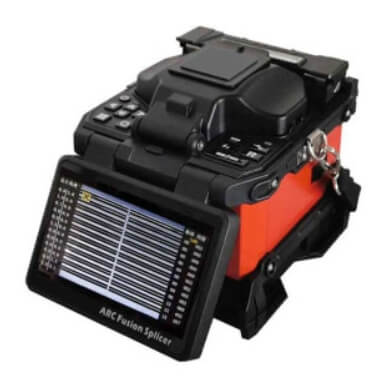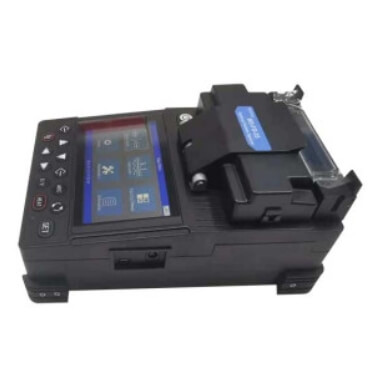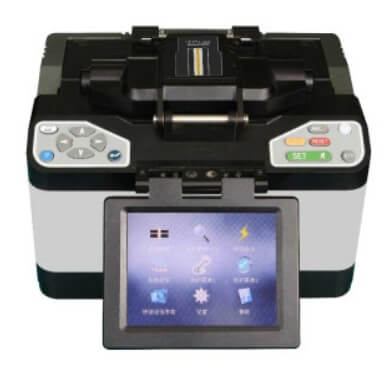Shanghai Gengyun Industrial Co., Ltd
(Fiber Welding Machine): Brief Introduction Of Optical Fiber Fusion Splicer
Fiber fusion splicer is a high-tech instrument and equipment that combines optics, electronics technology and precise machinery. Fiber welding machines are very important in the field of optical communications.

What is a fiber welding machine?
Fiber fusion splicers are mainly used to build and maintain optical cables in optical communications, so they are also called cable fusion splicers. The general working principle is to use a high-voltage arc to melt the cross sections of two fibers and use a high-precision motion mechanism to push the two fibers into one fiber to achieve coupling of the fiber mode field.
Types of fiber welding machines

Fiber fusion splicers can be classified into a variety of types according to specific functions and performance.
According to different welding objects, it can be divided into single-core fiber fusion splicers, multi-core fiber fusion splicers, functional fiber fusion splicers, sheath wire fusion splicers and fiber fusion splicers that maintain polarization. Single-core fiber fusion splicers are mainly used to weld single fibers with thinner diameters. This is a very common type on the market. Multi-core fiber fusion splicers can weld multiple optical fibers at the same time, greatly improving work efficiency. In addition, there are handheld fiber fusion splicers specially designed for field operations. and automatic fiber fusion splicers with automatic fusion and detection functions. According to different alignment methods, fiber fusion splicers can be divided into cladding alignment types and core alignment types. The cladding alignment type is mainly suitable for occasions such as fiber access in houses that do not require high-precision, and is relatively low in price. Equipped with a core alignment type with a six-motorco core alignment mechanism, a specially designed optical lens and software algorithm. It accurately recognizes fiber types and automatically selects matching fusion patterns. Ensure the quality of the fusion, so the price is relatively high.
How does fiber fusion splicer work

The working principle of fiber fusion splicers is mainly based on arc emission or laser heating technology. The end faces of the two optical fibers melt and fuse to one by high temperature to achieve the transmission of optical signals. Specifically, its workflow includes the following steps:
1. Cable stripping and fixing
First, the light needs to be stripped and secured to the fiber tray. Different types of optoelectronic cables (such as tilted bones and central tubes) require different peeling methods.
2. Fiber pretreatment
The stripped optical fibers passed through the heat shrink tube respectively. And the fiber end faces are prepared. The production quality of the fiber end faces directly affects the welding effect. Therefore, special stripping tools and fiber optic cutting knives are required to ensure that the end faces are flat and burr-free.
3.Welding preparation
Turn on the power of the fusion splicer and select the appropriate fusion method. Modern fiber fusion splicers usually have the function of automatically identifying the type of optical fiber. It can automatically select the appropriate fusion parameters.
4.Fusion process
Place the optical fiber into the fiber clamp of the fusion splicer, and press the splice button to start the fusion splicing operation. First, clean the fiber end face through electrode pre-discharge. Then the arc generated by high-voltage discharge melts the fiber end face. During this process, the fusion splicer captures real-time images through the optical lens. And use the microprocessor for image processing and recognition to ensure accurate alignment of the core or cladding. Finally, the fusion splicer reduces the gap so that the two optical fibers are completely fused.
5.Fusion point reinforcement
After the fusion completed, take out the optical fiber and heat the heat shrink tube with a heater to reinforce the fusion point. After heating, coil the optical fiber onto the fiber receiving tray and fix the optical fiber and related equipment. Complete the entire fusion process.
The Role and Advantages Of Fiber Optic Fusion Splicer
The role of fiber optic fusion splicer in the field of optical communication cannot ignored. It can not only connect two optical fibers together efficiently and stably. It can also reduce signal loss through advanced alignment and fusion technology. Improve the rate and stability of optical fiber transmission. In addition, the fiber optic fusion splicer also has the advantages of fast fusion speed, small heat-affected zone, and good fusion effect. It can significantly improve construction efficiency and reduce maintenance costs.
The Role of Fiber Optic Fusion Splicer
The main application areas of fiber optic fusion splicer include telecommunications operation and maintenance, communication engineering, fiber optic network construction and upgrading, data center interconnection, radio and television transmission systems, and fiber optic sensing and testing. For example, in the field of telecommunications, fiber optic fusion splicers help build high-speed and stable fiber optic networks. In data centers, it ensures high-speed and low-latency transmission of data. In the field of radio and television, it ensures stable transmission of signals. These application areas are highly dependent on the advanced connection technology of fiber optic fusion splicers to achieve lossless transmission of optical signals and stable operation of the network.
